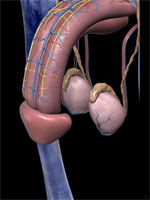
The penis is the external male sexual organ, as well as part of the urinary system. It contains several types of tissue, including skin, nerves, smooth muscle, and blood vessels.
The main part of the penis is known as the shaft, and the head of the penis is called the glans. At birth, the glans is covered by a piece of skin called the foreskin, or prepuce. The foreskin is often removed in infant boys in an operation called a circumcision.
Inside the penis are 3 chambers that contain a soft, spongy network of blood vessels. Two of these cylinder-shaped chambers, known as the corpora cavernosa, lie on either side of the upper part of the penis. The third lies below them and is known as the corpus spongiosum. This chamber widens at its end to form the glans. The corpus spongiosum surrounds the urethra, a thin tube that starts at the bladder and runs through the penis. Urine and semen travel through the urethra and leave the body through an opening in the glans of the penis, called the meatus.

Semen is made up of fluid produced by the prostate gland and the seminal vesicles (2 small sacs near the bladder and prostate), plus sperm cells that are made in the testicles. It is stored in the seminal vesicles. During ejaculation, semen passes into the urethra and out the meatus at the tip of the penis.
Cancers of the penis
Each of the tissues in the penis contains several types of cells. Different types of penile cancer (cancer of the penis) can develop in each kind of cell. The differences are important because they determine the seriousness of the cancer and the type of treatment needed.
Almost all penile cancers start in skin cells of the penis.
Squamous cell carcinoma
About 95% of penile cancers develop from flat skin cells called squamous cells. Squamous cell cancers can develop anywhere on the penis. Most of these cancers are found on the foreskin (in men who have not been circumcised) or on the glans. These tumors tend to grow slowly. If they are found at an early stage, these tumors can usually be cured.
Verrucous carcinoma: This is an uncommon form of squamous cell cancer that can occur in the skin in many areas. A verrucous carcinoma growing on the penis is also known as Buschke-Lowenstein tumor. This cancer looks a lot like a large benign genital wart. These cancers tend to grow slowly but can sometimes grow to a very large size. They can invade deeply into surrounding tissue, but they rarely spread to other parts of the body.
Carcinoma in situ (CIS): This is the earliest stage of squamous cell cancer of the penis. In this stage the cancer cells are only found in the top layers of skin -- they have not yet grown into the deeper tissues of the penis. Depending on the location of a CIS of the penis, doctors may use other names for the disease. CIS of the glans is sometimes called erythroplasia of Queyrat. The same condition when found on the shaft of the penis (or other parts of the genitals) is called Bowen disease.
Melanoma
Melanoma is a type of skin cancer that starts in melanocytes, the cells that make the brownish pigment that provides color to the skin and helps protect it from the sun. These cancers tend to grow and spread quickly and are more dangerous than other types of skin cancer. Although melanomas are most often found in sun-exposed skin, they do rarely occur in other areas. Less than 2% of penile cancers are melanomas.
Basal cell cancer
Basal cell cancer is another type of skin cancer that can develop on the penis. It makes up less than 2% of penile cancers. This type of cancer is slow-growing and rarely spreads to other parts of the body.
Adenocarcinoma (Paget disease of the penis)
This very rare type of penile cancer can develop from sweat glands in the skin of the penis. It can be very hard to tell apart from carcinoma in situ of the penis. At first, the cancer cells spread within the skin. Later on, these cells can invade, growing into the tissues underneath the skin and then spreading to lymph nodes.
Sarcoma
A small number of penile cancers develop from the blood vessels, smooth muscle, or other connective tissue cells of the penis and are called sarcomas. This document does not further discuss sarcoma.
Benign conditions of the penis
Sometimes, growths can develop on the penis that are abnormal but are not cancers (they are benign). These lesions can look like warts or irritated patches of skin. Like penile cancer, they are most often found on the glans or on the foreskin, but they can also occur along the shaft of the penis.
Condylomas
These are wart-like growths that look like tiny cauliflowers. Some are so small that they can only be seen when the skin is viewed under a magnifying lens. Others may be as large as an inch or more across. Condylomas are caused by infection with human papilloma virus (HPV).
Bowenoid papulosis
In this condition, dysplastic (abnormal) cells are seen only in the surface layer of the penile skin. This condition tends to occur in younger men and is seen as small, reddish, pimple-like patches on the shaft of the penis. Bowenoid papulosis can be mistaken for CIS, but most doctors agree it is not cancer or a pre-cancerous condition.

